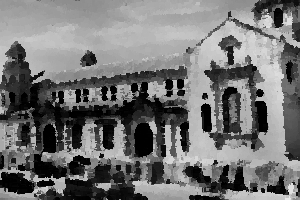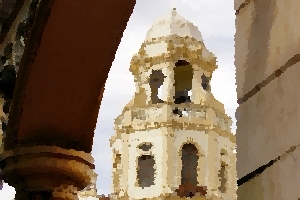The Basilica of the Black Nazarene, also known as Quiapo Church, is a Catholic religious building in the Quiapo district of Manila, Philippines. Built by the Franciscans in the early 17th century as the first church in the new district of Quiapo, it was rebuilt several times.
The presence of a statue of the Black Christ carrying his cross, considered miraculous, attracts many pilgrimage crowds. Pope John Paul II granted it the title of minor basilica in 1988. Pilgrims visit in such numbers that the church is open 24 hours a day. Masses are celebrated every hour.
Short History
The Quiapo district, north of Manila (and beyond the Pasig River), was founded on 29 August 1586 by Governor-General Santiago de Vera. Franciscan missionaries were entrusted with the pastoral care of the new inhabitants. The first church built in light material was destroyed by fire in 1639. It was rebuilt in a stronger material.
The second church collapsed in the earthquake of 1863. Although partially recoverable, it was replaced by a third church whose work was supervised by Fathers Eusebio de León and Manuel Roxas. It was completed in 1899.
 The side of the Quiapo Church in 1941. [CC] credit.
The side of the Quiapo Church in 1941. [CC] credit.On 30 October 1928, the church disappeared again in a fire. It was rebuilt without delay. The statue of the Black Nazarene escaped all these disasters without major damage, which added to its prestige and 'miraculous' reputation. It again emerged from the devastating bombing of Manila's city in February 1945, during the Second World War.
The church was renovated and enlarged in 1984 to accommodate the increasing numbers of pilgrims. In 1988, the church of Quiapo was declared a minor basilica by Pope John Paul II. On this occasion, the Apostolic Nuncio to the Philippines, Mgr Bruno Torpigliani, blessed the altar of Saint Lorenzo Ruiz, canonized a few months earlier in Rome (18 October 1987).
The Church today
 A bell tower of Quiapo Church. [CC] credit.
A bell tower of Quiapo Church. [CC] credit.The Basilica of Quiapo is located in a busy shopping area and is open 24 hours a day. Every Friday the weekly novena is attended by thousands of faithful. The annual procession on 9 January commemorates the transfer of the statue of the Black Nazarene to this church. Several hundred thousand people participate. The surrounding area lacks space, so there are occasional stampedes.